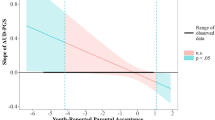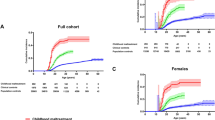Abstract
Purpose
The substantial literature showing that offspring of parents with alcohol use disorder (AUD) is at increased risk for externalizing psychopathology rarely examines the differential effects of parental and offspring sex. This literature also has other important limitations, such as modest sample sizes and use of unrepresentative samples. Using a large, nationwide Swedish sample, we aim to investigate the roles of parental and offspring sex in externalizing psychopathology among offspring with parental AUD.
Methods
AUD diagnosis and externalizing measures were obtained from national registries. Associations between outcomes and parental AUD were examined using logistic regressions. Parental and offspring sex effects were examined with interaction terms.
Results
Risks for externalizing disorders were increased in sons and daughters with parental AUD, with significant differences between sons and daughters for criminal behavior; maternal AUD had a greater impact than paternal AUD (regardless of offspring sex), but having two parents with AUD increased risk for all outcomes substantially more than having one parent; and maternal AUD increased risk of drug abuse for daughters more than sons, while paternal AUD increased risk of AUD and criminal behavior for sons more than daughters.
Conclusions
Offspring of parents with AUD are at increased risk for externalizing psychopathology. Maternal and paternal AUD differentially affected sons’ vs. daughters’ risks for AUD, drug abuse, and criminal behavior. The transmission of psychopathology within the externalizing spectrum appears to have sex-specific elements.


Similar content being viewed by others
References
Kendler KS, Gardner CO, Edwards A, Hickman M, Heron J, Macleod J, Lewis G, Dick DM (2013) Dimensions of parental alcohol use/problems and offspring temperament, externalizing behaviors, and alcohol use/problems. Alcohol Clin Exp Res 37(12):2118–2127. https://doi.org/10.1111/acer.12196
Chassin L, Pitts SC, DeLucia C, Todd M (1999) A longitudinal study of children of alcoholics: predicting young adult substance use disorders, anxiety, and depression. J Abnorm Psychol 108(1):106–119. https://doi.org/10.1037/0021-843x.108.1.106
Sher KJ, Walitzer KS, Wood PK, Brent EE (1991) Characteristics of children of alcoholics: putative risk factors, substance use and abuse, and psychopathology. J Abnorm Psychol 100(4):427
Knopik VS, Heath AC, Jacob T, Slutske WS, Bucholz KK, Madden PA, Waldron M, Martin NG (2006) Maternal alcohol use disorder and offspring ADHD: disentangling genetic and environmental effects using a children-of-twins design. Psychol Med 36(10):1461
Campbell KE, Zobeck T, Bertolucci D (1995) Surveillance report# 38: trends in alcohol-related fatal traffic crashes. National Institute on Alcohol Abuse and Alcoholism, Division of Biometry and Epidemiology, Rockville, pp 1977–1994
Cases M, Stinson FS, Dufour MC (1995) Surveillance report# 36: trends in alcohol-related morbidity among short stay community hospital discharges, United States 1979–1993. National Institute on Alcoholism, Bethesda (MD)
Rehm J, Room R, Van Den Brink W, Jacobi F (2005) Alcohol use disorders in EU countries and Norway: an overview of the epidemiology. Eur Neuropsychopharmacol 15(4):377–388. https://doi.org/10.1016/j.euroneuro.2005.04.005
Lundin A, Hallgren M, Forsman M, Forsell Y (2015) Comparison of DSM-5 classifications of alcohol use disorders with those of DSM-IV, DSM-III-R, and ICD-10 in a general population sample in Sweden. J Stud Alcohol Drugs 76(5):773–780
Kendler KS, Ohlsson H, Sundquist J, Sundquist K (2016) Alcohol use disorder and mortality across the lifespan: a longitudinal cohort and co-relative analysis. JAMA Psychiatry 73(6):575–581
Kessler RC, Aguilar-Gaxiola S, Alonso J, Chatterji S, Lee S, Ormel J, Ustun TB, Wang PS (2009) The global burden of mental disorders: an update from the WHO World Mental Health (WMH) surveys. Epidemiol Psichiatr Soc 18(1):23–33
Kessler RC, Chiu WT, Demler O, Merikangas KR, Walters EE (2005) Prevalence, severity, and comorbidity of 12-month DSM-IV disorders in the National Comorbidity Survey Replication. Arch Gen Psychiatry 62(6):617–627. https://doi.org/10.1001/archpsyc.62.6.617
Belliveau JM, Stoppard JM (1995) Parental alcohol abuse and gender as predictors of psychopathology in adult children of alcoholics. Addict Behav 20(5):619–625
Edwards EP, Eiden RD, Colder C, Leonard KE (2006) The development of aggression in 18–48 month old children of alcoholic parents. J Abnorm Child Psychol 34(3):409–423. https://doi.org/10.1007/s10802-006-9021-3
Wall TL, Garcia-Andrade C, Wong V, Lau P, Ehlers CL (2000) Parental history of alcoholism and problem behaviors in Native-American children and adolescents. Alcohol Clin Exp Res 24(1):30–34
Blazer DG, George LK (1993) Psychiatric disorders in adult children of alcoholics: data from the epidemiologic catchment area project. Am J Psychiatry 1(50):793
Yoon G, Westermeyer J, Kuskowski MA, Nesheim L (2013) Impact of the number of parents with alcohol use disorder on alcohol use disorder in offspring: a population-based study. J Clin Psychiatry 74(8):795–801
Pollock VE, Schneider LS, Gabrielli WF Jr, Goodwin DW (1987) Sex of parent and offspring in the transmission of alcoholism. A meta-analysis. J Nerv Ment Dis 175(11):668–673
Berkowitz A, Perkins HW (1988) Personality characteristics of children of alcoholics. J Consult Clin Psychol 56(2):206–209
Marino EN, Fromme K (2015) Alcohol-induced blackouts and maternal family history of problematic alcohol use. Addict Behav 45:201–206
Saunders GR, McGue M, Iacono WG, Elkins IJ (2016) Parent–offspring resemblance for drinking behaviors in a longitudinal twin sample. J Stud Alcohol Drugs 78(1):49–58
Mellentin AI, Brink M, Andersen L, Erlangsen A, Stenager E, Bjerregaard LB, Christiansen E (2016) The risk of offspring developing substance use disorders when exposed to one versus two parent (s) with alcohol use disorder: a nationwide, register-based cohort study. J Psychiatr Res 80:52–58
Harter SL (2000) Psychosocial adjustment of adult children of alcoholics: a review of the recent empirical literature. Clin Psychol Rev 20(3):311–337
Park S, Schepp KG (2015) A systematic review of research on children of alcoholics: their inherent resilience and vulnerability. J Child Fam Stud 24(5):1222–1231. https://doi.org/10.1007/s10826-014-9930-7
Ackerman RJ, Gondolf EW (1991) Adult children of alcoholics: the effects of background and treatment on ACOA symptoms. Int J Addict 26(11):1159–1172
Jennison KM, Johnson KA (1997) Resilience to drinking vulnerability in women with alcoholic parents: the moderating effects of dyadic cohesion in marital communication. Subst Use Misuse 32(11):1461–1489
Long EC, Lönn SL, Ji J, Lichtenstein P, Sundquist J, Sundquist K, Kendler KS (2017) Resilience and risk for alcohol use disorders: a Swedish twin study. Alcohol Clin Exp Res 41(1):149–155
Kendler KS, Sundquist K, Ohlsson H, Palmer K, Maes H, Winkleby MA, Sundquist J (2012) Genetic and familial environmental influences on the risk for drug abuse: a national Swedish adoption study. Arch Gen Psychiatry 69(7):690–697. https://doi.org/10.1001/archgenpsychiatry.2011.2112
Kendler KS, Lonn SL, Maes HH, Lichtenstein P, Sundquist J, Sundquist K (2016) A Swedish population-based multivariate twin study of externalizing disorders. Behav Genet 46(2):183–192. https://doi.org/10.1007/s10519-015-9741-7
SAS Insitiute Inc (2011) Version 9.3. SAS Institute, Cary
Kendler KS, Prescott CA, Myers J, Neale MC (2003) The structure of genetic and environmental risk factors for common psychiatric and substance use disorders in men and women. Arch Gen Psychiatry 60(9):929–937
Kramer MD, Krueger RF, Hicks BM (2008) The role of internalizing and externalizing liability factors in accounting for gender differences in the prevalence of common psychopathological syndromes. Psychol Med 38(1):51–61. https://doi.org/10.1017/S0033291707001572
Carle AC, Chassin L (2004) Resilience in a community sample of children of alcoholics: its prevalence and relation to internalizing symptomatology and positive affect. J Appl Dev Psychol 25(5):577–595. https://doi.org/10.1016/j.appdev.2004.08.005
Diaz R, Gual A, Garcia M, Arnau J, Pascual F, Canuelo B, Rubio G, de Dios Y, Fernandez-Eire MC, Valdes R, Garbayo I (2008) Children of alcoholics in Spain: from risk to pathology. Results from the ALFIL program. Soc Psychiatry Psychiatr Epidemiol 43(1):1–10. https://doi.org/10.1007/s00127-007-0264-2
Kim HK, Lee MH (2011) Factors influencing resilience of adult children of alcoholics among college students. J Korean Acad Nurs 41(5):642–651
King SM, Keyes M, Malone SM, Elkins I, Legrand LN, Iacono WG, McGue M (2009) Parental alcohol dependence and the transmission of adolescent behavioral disinhibition: a study of adoptive and non-adoptive families. Addiction 104(4):578–586. https://doi.org/10.1111/j.1360-0443.2008.02469.x
Disney ER, Iacono W, McGue M, Tully E, Legrand L (2008) Strengthening the case: prenatal alcohol exposure is associated with increased risk for conduct disorder. Pediatrics 122(6):e1225–e1230
Fryer SL, McGee CL, Matt GE, Riley EP, Mattson SN (2007) Evaluation of psychopathological conditions in children with heavy prenatal alcohol exposure. Pediatrics 119(3):e733–e741. https://doi.org/10.1542/peds.2006-1606
Bornovalova MA, Hicks BM, Iacono WG, McGue M (2010) Familial transmission and heritability of childhood disruptive disorders. Am J Psychiatry 167(9):1066–1074. https://doi.org/10.1176/appi.ajp.2010.09091272
Hicks BM, Foster KT, Iacono WG, McGue M (2013) Genetic and environmental influences on the familial transmission of externalizing disorders in adoptive and twin offspring. JAMA Psychiatry 70(10):1076–1083. https://doi.org/10.1001/jamapsychiatry.2013.258
Hicks BM, Krueger RF, Iacono WG, McGue M, Patrick CJ (2004) Family transmission and heritability of externalizing disorders: a twin-family study. Arch Gen Psychiatry 61(9):922–928. https://doi.org/10.1001/archpsyc.61.9.922
Prescott CA, Aggen SH, Kendler KS (1999) Sex differences in the sources of genetic liability to alcohol abuse and dependence in a population-based sample of US twins. Alcohol Clin Exp Res 23(7):1136–1144
Kendler KS, Ji J, Edwards AC, Ohlsson H, Sundquist J, Sundquist K (2015) An extended Swedish national adoption study of alcohol use disorder. JAMA Psychiatry 72(3):211–218
Kessler RC, McGonagle KA, Zhao S, Nelson CB, Hughes M, Eshleman S, Wittchen HU, Kendler KS (1994) Lifetime and 12-month prevalence of DSM-III-R psychiatric disorders in the United States. Results from the National Comorbidity Survey. Arch Gen Psychiatry 51(1):8–19
Kringlen E, Torgersen S, Cramer V (2001) A Norwegian psychiatric epidemiological study. Am J Psychiatry 158(7):1091–1098
Kendler KS, Gardner C, Dick DM (2011) Predicting alcohol consumption in adolescence from alcohol-specific and general externalizing genetic risk factors, key environmental exposures and their interaction. Psychol Med 41(7):1507–1516. doi:https://doi.org/10.1017/S003329171000190x
Acknowledgements
This project was supported by grants AA0235341 and K01AA024152 from the US National Institutes of Health, the Swedish Research Council (2014-2517), the Swedish Research Council for Health, Working Life and Welfare (in Swedish: FORTE; Reg. no. 2013-1836), and FORTE (Reg. no. 2014-0804) and the Swedish Research Council (2012-2378 and 2014-10134) as well as ALF funding from Region Skåne.
Author information
Authors and Affiliations
Corresponding author
Ethics declarations
Conflict of interest
On behalf of all authors, the corresponding author states that there is no conflict of interest.
Ethical standards
The study has been approved by the appropriate ethics committee and has, therefore, been performed in accordance with the ethical standards laid down in the 1964 Declaration of Helsinki and its later amendments.
Electronic supplementary material
Below is the link to the electronic supplementary material.
Rights and permissions
About this article
Cite this article
Long, E.C., Lönn, S.L., Sundquist, J. et al. The role of parent and offspring sex on risk for externalizing psychopathology in offspring with parental alcohol use disorder: a national Swedish study. Soc Psychiatry Psychiatr Epidemiol 53, 1381–1389 (2018). https://doi.org/10.1007/s00127-018-1563-5
Received:
Accepted:
Published:
Issue Date:
DOI: https://doi.org/10.1007/s00127-018-1563-5




